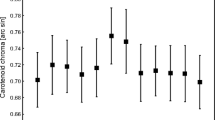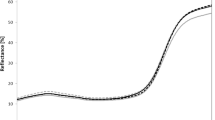Abstract
Female sticklebacks (Gasterosteus aculeatus) use the red coloration of males as a criterion for mate choice. Redder males are more attractive. However, males often differ not only in the intensity of their coloration (from dull to bright red) but also in color quality (from yellowish to purple-red). We investigated whether the red coloration of the stickleback is actually a multiple signal made by several pigments. We kept wild caught males singly in tanks until they had built a nest and were ready to accept females. Then, we took standard photographs and measured their colors by spectrometer analyses of the slides and by descriptions of human observers. These two measurements were highly correlated. When analyzing the carotenoid content of the sticklebacks' skin we found two groups of carotenoids (astaxanthin and tunaxanthin/lutein) that were quantified for each individual. The differences in color observed in the fish are correlated to this pigment quantification. Redder fish have more astaxanthin in their skin than yellowish fish, while the color of the yellowish fish appears to be made by tunaxanthin/lutein. Our results suggest that the red coloration of sticklebacks is a multiple trait that is made of at least two different carotenoids. This opens the possibility that male sticklebacks signal more detailed information to females than a one-dimensional trait would allow.
Similar content being viewed by others
REFERENCES
Andersson, M. 1994. Sexual Selection. Princeton, Princeton University Press.
Bakker, T. C. M. 1986. Aggressiveness in sticklebacks (Gasterosteus aculeatus L.: A behaviour-genetic study. Behaviour 98:1–144.
Bakker, T. C. M., and Milinski, M. 1991. Sequential female choice and the previous male effect in sticklebacks. Behav. Ecol. Sociobiol. 29:205–210.
Bakker, T. C. M., and Mundwiler, B. 1994. Female choice and male red coloration in a natural stickleback population. Behav. Ecol. 5:74–80.
Baube, C. L., Rowland, W. J., and Fowler, J. B. 1995. The mechanisms of colour-based mate choice in female threespine sticklebacks: hue, contrast and configurational cues. Behaviour 132:979–996.
Bendich, A. 1989. Carotenoids and the immune response. J. Nutr. 119:112–115.
Bendich, A. 1991. α-Carotene and the immune response. Proc. Nutr. Soc. 50:263–274.
Bendich, A., and Olson, J. A. 1989. Biological actions of carotenoids. FASEB J. 3:1927–1932.
Brush, A. H., and Reisman, H. M. 1965. The carotenoid pigments in the three-spined stickleback, Gasterosteus aculeatus. Comp. Biochem. Physiol. 14:121–125.
Christiansen, R., Glette, J., Lie, Ø., Torrissen, O. J., and WaagbØ, R. 1995. Antioxidant status and immunity in Atlantic salmon, Salmo salar L., fed semi-purified diets with and without astaxanthin supplementation. J. Fish Dis. 18:317–328.
Czeczuga, B. 1980. Carotenoids in fish. XXVI. Pungitus pungitus (L.) and Gasteosteus aculeatus L. (Gasterosteidae). Hydrobiologia 74:7–10.
Endler, J. A. 1990. On the measurement and classification of colour in studies of animal colour patterns. Biol. J. Linn. Soc. 41:315–352.
Fisher, R. A. 1930. The Genetical Theory of Natural Selection. Clarendon Press, Oxford.
Frischknecht, M. 1993. The breeding coloration of male three-spined sticklebacks (Gasterosteus aculeatus) as an indicator of energy investment in vigour. Evol. Ecol. 7:439–450.
Grafen, A. 1990. Biological signals as handicaps. J. Theor. Biol. 144:517–546.
Gray, D. A. 1996. Carotenoids and sexual dichromatism in North American passerine birds. Am. Nat. 148:453–480.
Hamilton, W. D., and Zuk, M. 1982. Heritable true fitness and bright birds: a role for parasites? Science 218:384–387.
Houde, A. E., and Torio, A. J. 1992. Effect of parasitic infection on male color pattern and female choice in guppies. Behav. Ecol. 3:346–351.
Johnstone, R. A. 1995. Honest advertisement of multiple qualities using multiple signals. J. Theor. Biol. 177:87–94.
Kodric-Brown, A. 1989. Dietary carotenoids and male mating success in the guppy: An environmental component to female choice. Behav. Ecol. Sociobiol. 25:393–401.
Krinsky, N. I. 1993. Actions of carotenoids in biological system. Annu. Rev. Nutr. 13:561–587.
Krinsky, N. I. 1994. The biological properties of carotenoids. Pure Appl. Chem. 66:1003–1010.
Lozano, G. A. 1994. Carotenoids, parasites, and sexual selection. Oikos 70:309–311.
Lythgoe, J. N. 1979. The Ecology of Vision. Clarendon Press, Oxford.
Matsuno, T. 1989. Animal carotenoids, pp. 59–74, in N. I. Krinsky, M. M. Mathew-Roth, and R. F. Taylor (eds.). Carotenoids. Chemistry and Biology. Plenum Press, New York.
Matsuno, T., and Katsuyama, M. 1976. Comparative biochemical studies of carotenoids in fishes XI: Carotenoids of two species of flying fish, mackerel pike, killifish, three-spined stickleback and Chinese eight-spined stickleback. Bull. Jpn. Soc. Sci. Fish 42:761–763.
Milinski, M., and Bakker, T. C. M. 1990. Female sticklebacks use male coloration in mate choice and hence avoid parasitized males. Nature 344:330–333.
Milinski, M., and Bakker, T. C. M. 1991. Sexuelle Selektion: Stichlingsweibchen erkennen parasitierte Männchen nur an deren Balzfärbung. Verh. Dtsch. Zool. Ges. 84:320.
Milinski, M., and Bakker, T. C. M. 1992. Costs influence sequential mate choice in sticklebacks, Gasterosteus aculeatus. Proc. R. Soc. London Ser. B 250:229–233.
Moodie, G. E. E. 1972. Predation, natural selection and adaptation in an unusual threespined stickleback. Heredity 28:155–167.
Pfander, H. 1989. Key to Carotenoids, 2nd ed. Birkhäuser, Basel.
Rowland, W. J. 1983. The relationships among nuptial coloration, aggression, and courtship of male three-spined sticklebacks, Gasterosteus aculeatus. Can. J. Zool. 62:999–1004.
Schiedt, K., and Liaaen-Jensen, S. 1995. Isolation and analysis, pp. 81–108, in G. Britton, S. Liaaen-Jensen, and H. Pfander (eds.). Carotenoids, Vol. IA. Birkhäuser, Basel.
Simpson, K. L., Katayama, T., and Chichester, C. O. 1981. Carotenoids in fish feeds, pp. 462–538, in J. C. Bauemfeind (ed.). Carotenoids as Colorants and Vitamin A Precursors. Academic Press, New York.
Skarstein, F., and Folstad, I. 1996. Sexual dichromatism and the immunocompetence handicap: An observational approach using Arctic charr. Oikos 76:359–367.
Wedekind, C. 1992. Detailed information about parasites revealed by sexual ornamentation. Proc. R. Soc. London Ser. B 247:169–174.
Wedekind, C. 1994. Mate choice and maternal selection for specific parasite resistances before, during and after fertilization. Phil. Trans. R. Soc. London Ser. B 346:303–311.
West, C. E., Rombout, J. H. W. M., van der Zijpp, A. J., and Sijtsma, S. R. 1991. Vitamin A and the immune function. Proc. Nutr. Soc. 50:251–262.
Zahavi, A. 1975. Mate selection—a selection for a handicap. J. Theor. Biol. 53:205–214.
Zuk, M., Johnson, K., Thornhill, R., and Ligon, J. D. 1990. Parasites and male ornaments in free-ranging and captive red jungle fowl. Behaviour 114:232–248.
Author information
Authors and Affiliations
Rights and permissions
About this article
Cite this article
Wedekind, C., Meyer, P., Frischknecht, M. et al. Different Carotenoids and Potential Information Content of Red Coloration of Male Three-Spined Stickleback. J Chem Ecol 24, 787–801 (1998). https://doi.org/10.1023/A:1022365315836
Issue Date:
DOI: https://doi.org/10.1023/A:1022365315836




